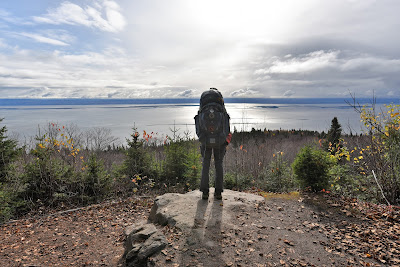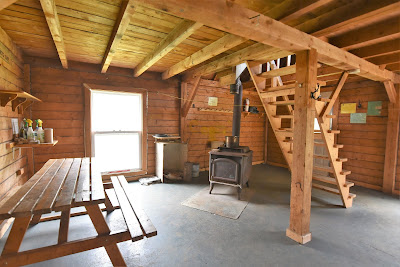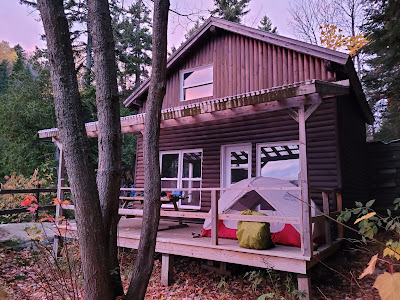Rivers of Mud : Refuge Vache to Camp Faille
We woke up around 6:30 am and lay in our warm, cozy cabin, looking out the windows and waiting for it to get light enough to make breakfast. We lit a small fire in the stove, made coffee, went down to the water source to filter water for the day, and swept the cabin. After procrastinating as long as possible, we reluctantly set off into the cool (3°C), overcast, windy, morning.
Our hike on the Sentier Transcanadien through Sentier des Caps began with a short but rather steep climb up a mossy, rocky slope, which helped to warm us up. We then wove down into a sheltered valley filled with balsam fir. We were tickled to spot a white birch that had been partially peeled by a porcupine. We could see its many teeth marks on the smooth golden brown wood beneath the outer layer of bark, and we could imagine the soft munching sound it must have made while eating. This was the first of several porcupine feasts we spotted along the trail today.
For the next few kilometres the trail gently undulated up and down along the sides of forested hills and ridges. As we walked through treed stands where many of the leaves had fallen it felt like the world was upside down. Overhead was a heavy, steely grey sky, and underfoot was a blanket of yellow leaves, shining like the sun.
We soon found ourselves walking through a sugar maple stand on the side of a steep hill facing the Saint Lawrence Seaway. We could see through the tree trunks and bare branches out to the shining grey waters of the wide river, and to the layered blue mountains beyond that faded into the distance. It was a wonderful feeling to scuff through the thick layer of golden brown leaves on the ground, bringing back childhood memories and kicking up the earthy smell of fall while enjoying the view.
As the trail meandered along we were very grateful to trail builders who made sure there was always a red and white blaze in sight. At times it was a bit difficult to see the footpath under the blanket of leaves, and the markers really helped. In many spots the trail was quite muddy and slippery as well, and the leaf covering made it more difficult to navigate these sections, especially on the steep descents. Despite the minor challenges, it was a very pleasant walk.
Eventually we made our way down into another forested valley and crossed a clear, fast moving stream on a small footbridge. The surrounding hills cut off all sounds from the outside world, so the only noise we heard was the happy chatter and babble of the brook. It is a rare gift to be out of earshot of the sounds of modern society, and we enjoyed every moment of our solitude.
From there we began a rather long and steep ascent up what looked and felt more like a rocky creek bed than a pathway. It was slippery and muddy, and in places small rivulets of water trickling down the trail under the leaves. As we paused half way up to catch our breath we watched a pair of Hairy Woodpeckers foraging for insects on a nearby white birch. In the distance we could hear a White-breasted Nuthatch calling, and as we stood there a small flock of Purple Finches passed noisily through the canopy.
Eventually we emerged high up on a ridge, just as the sun came out and lent some warmth to the breezy morning. The footpath cut through a patch of prickly raspberry and blackberry bushes, and then took us along a corridor with dense conifers on one side and an open slope to the Saint Lawrence on the other. We could hear the wind howling above and around us, but thankfully the trail was tucked into a sheltered corridor that protected us.
We followed the ridge for a few kilometres, stopping to enjoy the magnificent views from several different viewpoints. As we saw the rolling hills stretched out along the shore, still covered by patches of fall colours and lit by the sun, we understood why this is called the gold coast. Looking down on the sandy shoals and small islands in the silvery waters of the Saint Lawrence we also realized that much of the waterway must be very shallow in this area. Out in the middle of the shimmering waters we could see Saint-Antoine-de-l'Isle-aux-Grues and L'Ile-au-Canot, their surfaces covered with emerald green fields, and their edges dotted with tiny looking white homes and the spires of a church. On this relatively clear day we could see the towns and villages on the far shore of the river as well, and the mountains receding behind them. It was incredibly beautiful!
When we came down off the ridge we found ourselves in a very wet, swampy, low-lying area. A series of boardwalks had been laid over the worst of the puddles and streams, but many were loosely laid over logs, and very bouncy to cross. In other spots we picked our way across the muddy sections as best we could, which slowed us down somewhat.
Around 11:30 we arrived at Refuge Cap Gribane. The small cabin was in a grassy clearing in the trees, tucked in among the mountains. As we approached the shelter a column of wood smoke was rising from its chimney. We stepped inside to warm up and take a break, and spent a pleasant half hour relaxing in the cozy warmth and enjoying the smell of wood smoke.
After our welcome break we climbed back up onto another ridge. From this
vantage point we got a spectacular view down the forested valley. The
steep green and brown forested hills were broken by small patches of yellow
leaves that stubbornly hung in, and splashes of red made by the plump, juicy
berries of mountain ash. At the bottom of the valley was a wide hydro
corridor, providing a reminder of Quebec's dedication to clean energy sources
in general and hydroelectric power generation in particular.
We quickly got cold standing in the wind on the exposed ridge, so we were grateful to make our way back down into more sheltered forest stands again. In general, the trail became easier to navigate between the Cap Gribane Refuge and the Départ des Sentiers, or the end of the trail near Saint-Tite-des-Caps.
Trail conditions in this section were described as suitable for day hikers and inexperienced hikers, and in many spots ropes, boardwalks, and bridges had been placed to aid in ascending and descending hills or crossing wet areas. Strangely, while extra guidance was provided in some spots, in others we were left to scramble up or down, or step across across muddy patches on our own. In any case, the going was much easier in this section and our pace picked up.
As we approached Saint-Tite-des-Caps the path followed the bottom of a tall rock face that had many interesting crevices and moss covered ledges. A highlight was stopping for a rest at the Abris Sous Roches, which was a large overhanging rock that formed a sort of cave with natural rock ledge benches inside. We perched on the rock in the natural shelter for a rest and a granola bar before continuing on.
Around 2:30 pm we came to the official end of the Sentier des Caps Trail. It was marked with a roofed bridge over a small stream that had a couple benches built into the sides. A light rain had begun to fall, so we sat under the roof for a few minutes, enjoying the sights and sounds of the water flowing beneath us. We had been a little worried about our ability to complete this section of the Sentier Transcanadien, and although we aren't quite finished it, reaching this point felt like a milestone.
We set off for the final 2.2 km of our hike to the Refuge La Faille in a light rain. It was a relatively easy walk through the forest, and we passed several other sets of hikers along the route, who all exchanged friendly words and smiles. When we arrived we discovered that the cabin is called La Faille, or The Fault, because it is located along a huge crevice in the rock. The cabin is tucked into the trees on the edge of a cliff with a view out to the Saint Lawrence Seaway along the fault line.
Apparently the cabin is being quarantined at the moment, but we were allowed to camp for the night, and we set the tent up while enjoying the view. As we made dinner the clouds parted for a while, forming long ribbons above the water through which blue sky was visible. Patches of sunshine moved across the landscape, lighting up the islands in the waterway and then plunging them into darkness. We enjoyed a brilliant pink sunset, and then as the light faded to darkness we watched thousands of twinkling lights come on across the water.
As darkness descended several large flocks of Snow Geese flew by overhead, their loud, clear voices resonating among the cliffs. A little later, on the edge of hearing we could just make out the voices of what sound like thousands of Snow Geese down below us on the water. It is a curious sound, kind of like listening to the guests at a large and distant party. Apart from the faint gabbling of the geese and the sound of leaves falling on the forest floor around us, the night is perfectly quiet.
We are thoroughly enjoying our last night on the Sentier de Cap trail, completely immersed in the sights, sounds, and smells of nature.
See you on the trail!
Remember to follow our entire adventure here : www.comewalkwithus.online














































Comments
Post a Comment